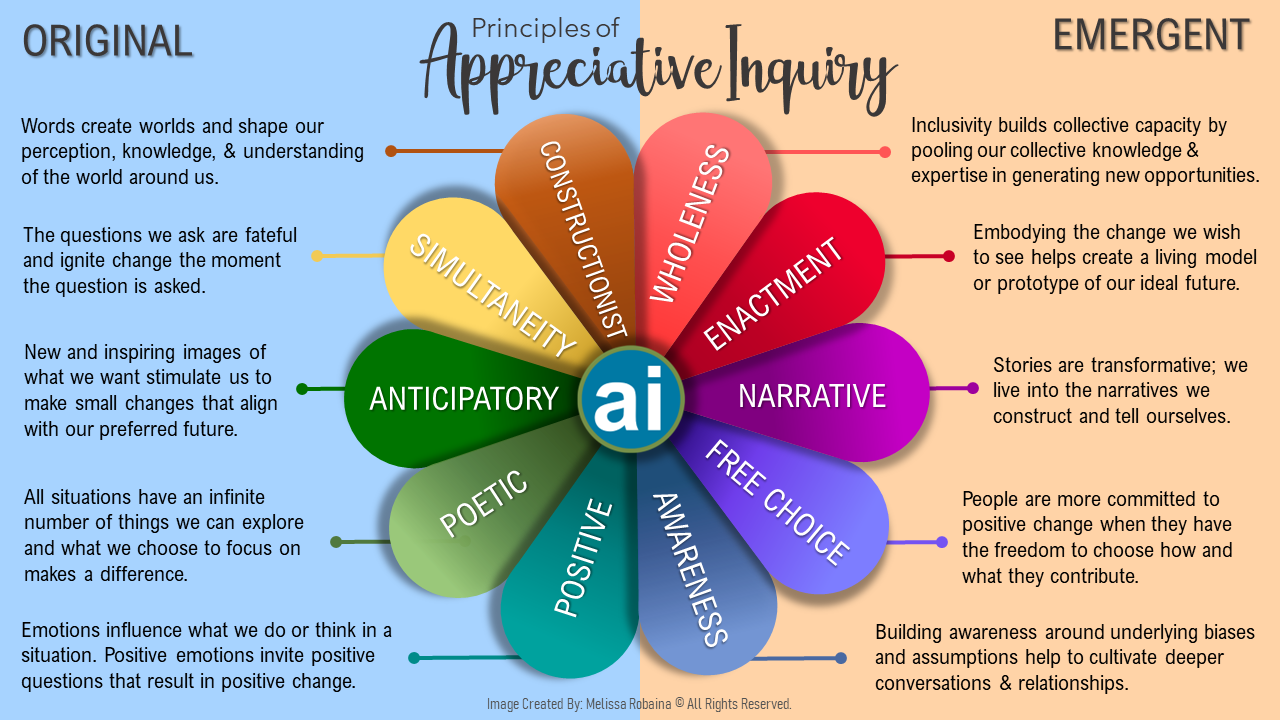WHAT ARE THE AI PRINCIPLES AND WHAT PURPOSE DO THEY SERVE?
The principles are the foundation to Appreciative Inquiry. The five original principles of appreciative inquiry, created in the early 1990’s by David Cooperrider and Suresh Srivastva, explain the basic tenets of the methodology. The five original principles are: the Constructionist Principle, the Simultaneity Principle, the Anticipatory Principle, the Poetic Principle, and the Positive Principle.
As new learning, thinking, and information became available, additional principles, referred to as the emergent principles of Appreciative Inquiry, were added. The five emergent principles are: the Wholeness Principle, the Enactment Principle, the Free Choice Principle, the Narrative Principle, and the Awareness Principle.
ORIGINAL PRINCIPLES
CONSTRUCTIONIST PRINCIPLE // Words Create Worlds
Words create and shape our perception, knowledge, and understanding of the world around us. Reality, as we know it, is subjective and is socially created through language and conversations.
SIMULTANEITY PRINCIPLE // QUESTIONS SPARK CHANGE
Inquiry is an intervention. The moment we ask a question, we begin to create a change. This makes the questions we ask incredibly important as they can influence the action taken. “The questions we ask are fateful” is a common phrase among AI practitioners when discussing this principle.
ANTICIPATORY PRINCIPLE // IMAGE INSPIRES ACTION
Human systems move in the direction of their images of the future. New and inspiring images of what we want stimulate us to make small changes that align with our preferred future. The more positive and hopeful the image of the future, the more positive the present-day action.
POETIC PRINCIPLE // WE CAN CHOOSE WHAT TO STUDY
All situations have an infinite number of things we can explore and what we choose to focus on makes a difference.
POSITIVE PRINCIPLE // POSITIVE QUESTIONS LEAD TO POSITIVE CHANGE
Emotions influence what we do or think in a situation. Positive emotions invite positive questions that result in positive change.
EMERGENT PRINCIPLES
WHOLENESS PRINCIPLE // INCLUSIVITY BUILDS COLLECTIVE CAPACITY
The Wholeness Principle surfaces the best in people and organizations. Bringing all stakeholders together stimulates creativity and builds collective capacity by pooling the group’s collective knowledge and expertise in generating new opportunities.
ENACTMENT PRINCIPLE // ACTING “AS IF” IS SELF-FULFILLING
To really make a change, we must “be the change we want to see.” Embodying the change we wish to see helps create a living model or prototype of our ideal future.
NARRATIVE PRINCIPLE // STORIES ARE TRANSFORMATIVE
Stories are transformative; we live into the narratives we construct and tell ourselves.
FREE CHOICE PRINCIPLE // FREEDOM OF CHOICE EMPOWERS
People are more committed to positive change when they have the freedom and space to choose how, what, and when they contribute.
AWARENESS PRINCIPLE // SURFACE HIDDEN ASSUMPTIONS & BIASES
To cultivate meaningful conversations and strengthen relationships, it is important to build awareness to help surface underlying biases and assumptions that may impede progress and change.
Discover More
Explore the links below and start inspiring positive change in individuals and organizations today!
- Learn more about becoming certified.
- Use our resources and find other ways to be involved with the Center for Appreciative Inquiry.
- Search our directory to find a certified AI Professional to help you achieve change in your organization.
- Find upcoming training courses and programs designed to help you learn and apply Appreciative Inquiry to facilitate change, fuel productive and meaningful conversations, use visuals and AI in designing meetings, 1:1 coaching, and so much more!


